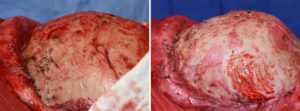Background: The skull is usually depicted as having an oblong shape with an overall smooth surface. While this is usually true, it is prone to have numerous bony irregularities. Most of skull irregularities occur along its suture lines particlerly where the differ suture lines merge. This would be understandable as these are areas of bone union and growth during the development and growth of the skull.

There are numerous horizontal nuchal lines on the upper occipital region of the skull. The upper nuchal line, the most faint, often called the Mempin line is where the epicranial aponeurosis attaches. The most prominent is the superior nuchal line below it where numerous neck muscles attach including the splenius capitis, trapezius, occipitalis and the sternocleidomastoid.
Because of the lambdoidal suture and the attachments of the neck muscles, it is very prone to irregularities and protrusions across the back of the head. These often appear externally as a raised horizontal ridge that has an irregular shape and feel to it. The shorter one’s hair is the more such bony prominences may appear.
Case Study: This young man was bothered by a raised protrusion on the back of his head. It was a horizontal palpable line of bone that was quite irregular. He had a prior skull surgery that was a brow bone reduction done through a full coronal scalp incision.


Highlights:
1) The most commonly request are for skull reduction is the back of the head.
2) Back of the head protrusions can be caused by occipital knobs, nuchal ridge prominences, asymmetries or an overall generalized bony protrusion.
3) Occipital bone reduction is primarily done by a high-speed burring technique.
Dr. Barry Eppley
Indianapolis, Indiana



